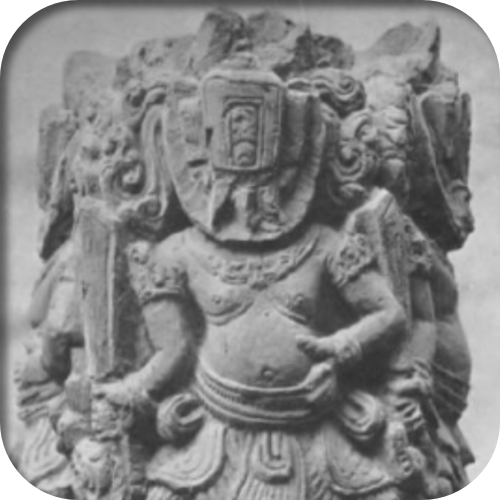The Function and Meaning of Catuḥkāya Statue in Ancient Bali Fungsi dan Makna arca catuḥkāya pada masa Bali Kuno
Main Article Content
Abstract
Catuḥkāya is a monolithic statue featuring four human figures carved on its sides, representing the cardinal directions: south, east, north, and west. This study examined the function and meaning of catuḥkāya statues in ancient Balinese. Data collected from field surveys and literature reviews was analyzed with the iconographic and comparative approach. Study results’s shows that the catuḥkāya statue is the development of Mukhaliṅga. In the past, the catuḥkāya statue was most likely part of the Shiva Tantrayana’s ritual and used for abhicāra (ceremonies for destroying enemies). The meaning implied in the catuḥkāya statue is the embodiment of universe (microcosm and macrocosm) consist of soft form (tānmatra) and rough form (mahābhūta).
Article Details

This work is licensed under a Creative Commons Attribution-NonCommercial-ShareAlike 4.0 International License.
References
Chawdri, L. . (1992). Secrets of yantra, mantra, and tantra. New Dawn Press, Inc.
Chawdri, L. . (1998). Praticals of yantras. Sagar Public.
Donder, I. K. (2015). Keesaan Tuhan dan peta wilayah kognitif teologi Hindu: kajian pustaka tentang pluralitas konsep teologi dalam Hindu. Harmoni: Jurnal Mulikultural dan Multireligius, 14(2), 22–35.
Dowson, J. (2000). A classical dictionary of Hindu mythology and religion: geography, history, and literature. D.K Printworld (p) Ltd.
Geria, M. (2000). Benang merah persebaran arca perwujudan di Bali. Forum Arkeologi, 1(1), 71–81.
Gonda, J. (1996). Viṣṇuism and śivaism: a comparison. Munshiram Manoharlal Publisher Pvt. Ltd.
Hadiwijono, H. (2019). Agama Hindu dan Buddha (21 ed.). BPK Gunung Mulia.
Kempers, A. J. B. (1991). Monumental Bali: introduction to Balinese archaeology, guide to monuments. Published by Periplus Edition, Inc.
Kramrisch, S. (1981). The presence of Śiva. Princeton University Press.
Mardiwarsito, L., Adiwimarta, S. S., & Suratman, S. T. (1992). Kamus Indonesia-Jawa kuno. Departemen Pendidikan dan Kebudayaan.
Margaret, & Stutley, J. (1977). A dictionary of Hinduism: its mythology, folklore, and development 1500 B.C-A.D. 1500 (Routledge (ed.)).
Munandar, A. A. (2019). Archaeological artifacts as expressive desire of Hindu-Buddha religions in Java. International review of Humanities Studies, 4(2), 676–688. https://doi.org/https://doi.org/10.7454/irhs.v4i2.174
Murdihastomo, A. (2021). Arca tokoh dewa bersorban di Museum Nasional Indonsia. Forum Arkeologi, 34(1), 1–14. https://doi.org/http://dx.doi.org/10.24832/fa.v34i1.688
Patera, I. wayan. (1983). Arca-arca caturkaya di Desa Pejeng Gianyar. Universitas Udayana.
Prawirajaya R, K. D., Purwanto, H., & Tirtasari, C. P. (2022). Menggali makna ikonografis pada arca bersifat tantris di Pura Kebo Edan, kabupaten Gianyar, Bali. Amerta: Jurnal Penelitian dan Pengembangan Arkeologi, 40(2), 125–144. https://doi.org/10.55981/amt.2022.41
Rajeg, K. D. P., & Titasari, C. P. (2021). Menggali makna ikonografis pada arca bersifat tantris di pura Kebo Edan, kabupaten Gianyar, Bali.
Rao, G. (1916). Elements of Hindu iconograpy. The Law Printing House.
Rema, N. (2014). Arca Ganesa dalam sikap Swastikàsana. Berkala Arkeologi Sangkhakala, 17(2), 155–168. https://doi.org/https://doi.org/10.24832/bas.v17i2.83
Soebadio, haryati. (1985). Jnanasiddhanta. Djambatan.
Soekatno, E. S. H. (1993). Arca tidak beratribut Dewa di Bali - Sebuah kajian ikonografis dan fungsional. Universitas Indonesia.
Srinivasan, D. M. (1997). Many heads, arms, and eyes: origin, meaning, and form of multiplicty in Indian art. Koninklijke Brill.
Stutley, M. (2019). The illustrated dictionary of Hindu iconography. Routledge.
Stutterheim, W. F. (1956). Studies in Indonesian archaeology. Martinus Nijhoff.
Stutterheim, W. F. (1981). Oudheden van Bali (I. G. N. Tjakra (ed.)). Hotel Dirgapura.
Tanudirjo, D. A. (1989). Ragam metode penelitian arkeologi dalam skripsi karya mahasiswa arkeologi UGM.
Tenaya, I. W. G. Y., Artanegara, I. G. A. G., Wahyuni, N. M. D., & Murdimanto, A. (2021). Tinggalan arkeologi di daerah aliran sungai Pakerisan dan Petanu. Balai Pelestarian Cagar Budaya Bali.
Tim Penyusun KBBI. (2020). KBBI V (V). Badan Pengembangan Bahasa dan Perbukuan, Kementerian Pendidikan dan Kebudayaan Republik Indonesia.
Tim Penyusun Propinsi Bali. (2003). Śiwatattwa. Pemerintah Propinsi Bali.
Williams, G. (2003). Handbook of Hindu mythology. ABC-CLIO, Inc.
Wirjosuparto, S. (1952). Candakaranika adiparwa: kamus bahasa Djawa-Kuna-Indonesia. Indira.
Zoetmulder. (1983). Kalangwan: sastra Jawa kuno selayang pandang. Djambatan.

